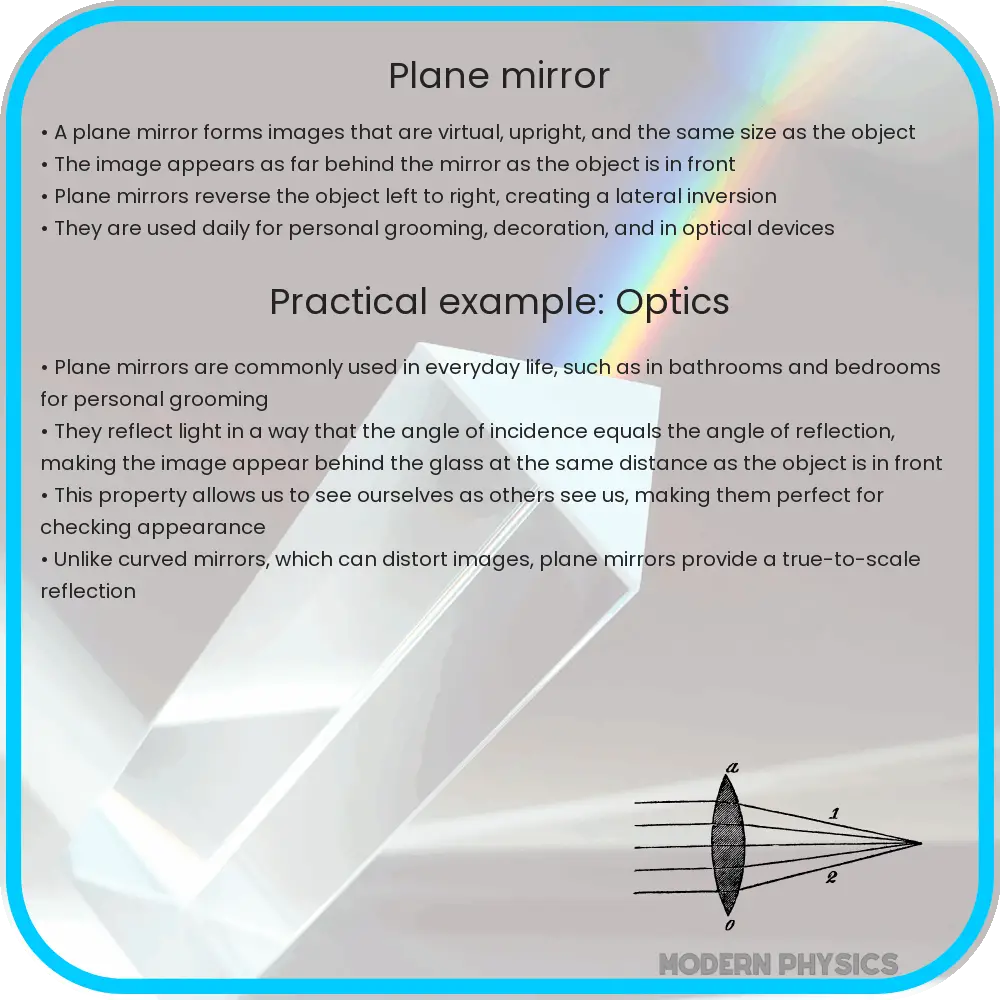Explore the fascinating world of plane mirrors, uncovering their reflection laws, image properties, and diverse applications in daily life and science.

Understanding Plane Mirrors: The Basics of Reflection and Image Formation
Plane mirrors are a fundamental component in the realms of physics and everyday life. A plane mirror is essentially a flat mirror that reflects light and images in a consistent and predictable manner. Understanding how plane mirrors work involves exploring the laws of reflection, the nature of the images they produce, and their wide-ranging applications.
Laws of Reflection
At the core of plane mirror functionality are the laws of reflection. These laws govern how light behaves when it encounters a reflective surface. The first law states that the incident ray (the incoming ray), the reflected ray, and the normal (perpendicular line to the point of incidence) all lie in the same plane. The second law, known as the angle of reflection, asserts that the angle of incidence (θi) is always equal to the angle of reflection (θr). Mathematically, it is expressed as θi = θr. This predictability is what makes plane mirrors so useful in a variety of applications.
Characteristics of Images Formed by Plane Mirrors
Images formed by plane mirrors possess distinct characteristics. Firstly, the image is always virtual, meaning it cannot be projected onto a screen as it appears to be behind the mirror. Additionally, the image is upright and of the same size as the object. Another key feature is the principle of laterality; the image is laterally inverted, which means left and right are reversed in the reflection. This property is often observed in the way letters appear reversed in a mirror.
Applications of Plane Mirrors
- Everyday Use: Plane mirrors are most commonly seen in household items such as bathroom mirrors, dressing mirrors, and decorative mirrors. They are essential for personal grooming and interior decoration.
- Periscopes: In periscopes used in submarines and tanks, plane mirrors are positioned at 45° angles to allow operators to see objects not in their direct line of sight.
- Solar Power Plants: Large plane mirrors, known as heliostats, are used to redirect sunlight to a central receiver to generate electricity.
Continuing with further intriguing aspects and specific scientific principles behind plane mirrors, we delve deeper into their optical properties and additional applications in the following section.
Optical Properties and Additional Applications of Plane Mirrors
Plane mirrors also have unique optical properties that make them ideal for specific applications. The phenomenon of symmetry in plane mirror reflections is one such property. When an object is placed in front of a plane mirror, the image appears as if the object has been symmetrically transposed behind the mirror. This property is widely used in optical illusions and in certain architectural designs to create an impression of space and depth.
Another aspect of plane mirrors is their ability to produce a number of reflections when two mirrors are placed facing each other. This setup, known as an ‘infinity mirror’, creates a series of diminishing reflections that appear to recede into infinity. This effect is used in art installations, amusement parks, and decorative lighting to create a sense of endless space.
Scientific and Technological Applications
- Astronomy: Plane mirrors are used in certain types of telescopes, where they serve as secondary mirrors to redirect light to a focal point for clearer observation.
- Optical Instruments: Instruments like kaleidoscopes and periscopes use plane mirrors to direct light paths and create visual effects.
- Lasers and Laboratory Equipment: In laser systems, plane mirrors are used to steer or reflect laser beams precisely. They are also used in spectroscopy and other laboratory setups for directing light.
Conclusion
Plane mirrors are not just everyday objects but are also integral components in various scientific and technological fields. Their unique properties like producing virtual, upright, and laterally inverted images, along with their ability to obey the laws of reflection, make them invaluable in both practical and experimental applications. From enhancing our daily lives in personal grooming to playing crucial roles in advanced scientific research and renewable energy, plane mirrors demonstrate the beauty and utility of simple physics principles in diverse domains. Their simplicity, effectiveness, and versatility ensure that plane mirrors will remain essential tools in both our mundane and extraordinary endeavors.
